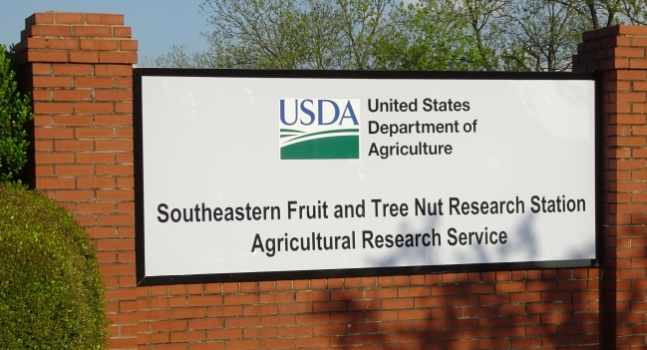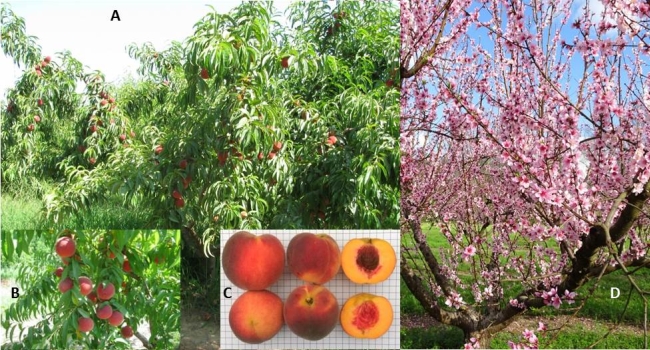Photo Carousel Links
The Southeastern Fruit and Tree Nut Research Laboratory of the USDA-ARS has a mission to enhance the production, value, and safety of pecan, peach, nectarine, and plum crops; to enhance economic competitiveness of farm operations engaged in the production of these crops; and to ensure the successful contribution of these crops to the American economy.
New rootstocks are needed to reduce industry losses to peach tree short life (PTSL) (Fig. A) and Armillaria root rot (ARR) (Fig. B). The rootstock breeding program at the SEFTNRL has released two rootstocks: Guardian (1993) , a peach seedling rootstock resistant to PTSL, and MP-29 (2011) , a clonal semi-dwarf plum-peach hybrid resistant to PTSL, ARR, and most RKN.
Research to reduce the impact of yield-limiting diseases of pecan and stone fruit. A. Pecan scab on pecan. B. Spores of pecan scab (Venturia effusa), which is splash and wind dispersed. C. Understanding use of fungicide sprays to manage diseases in tall pecan trees. D. A peach fruit with symptoms of peach scab.
The SEFTNRL stone fruit breeding program has provided most of the cultivars utilized by the SE peach industry since 1937. Breeding priorities include large fruit size, good firmness, freestone, balanced sugar/acid ratio, rich flavor, attractive appearance, healthy vegetation, and reliable cropping. Advanced selection (A), limb (B), fruit (C), and bloom (D).
Entomological research for peach and pecan production addresses pest problems using (clockwise from top left): gibberellic acid to mitigate chlorotic injury by the black pecan aphid, banker plants in orchards to enhance natural enemies, mating disruption against borers attacking peach, stink bug monitoring, and pecan weevil control.
A: An entomopathogenic nematode. These beneficial nematodes (round worms) are naturally occurring biopesticides that can kill various insect pests in pecan, peach and other cropping system.
B: Entomopathogenic nematodes applied for control of peachtree borer.
Mission
The mission of the Fruit and Tree-Nut Research Unit is to meet agriculture sector needs (both small and large farms) for a) stone fruit (peach nectarine, plum) scion and rootstock cultivars, and b) production and management strategies and tools to enable economic production and protection of pecan and stone fruit crops. Breeding efforts will produce: a) stone fruit scion cultivars satisfying a wide range of market niches with fruit possessing high quality and resistance to diseases (bacterial spot, brown rot, and scab), and b) rootstocks conferring enhanced tree longevity (tolerance to oak root rot, nematodes, and peach tree short life). Protection efforts will produce: a) management strategies and tools for economic control of primary arthropod pests of stone fruits (catfacing insects, borers, plum curculio, and scale) and pecan (weevils, aphids, mites, shuckworm, casebearers, stinkbugs, and mirids), and b) management strategies and tools for economic control of primary disease pests of stone fruits (scab, brown rot, root rots, nematodes, bacterial spot) and pecan (pecan scab and shuck decline). Production related research efforts will produce cultural strategies and tools to mitigate irregular bearing of pecan and increase production efficiency.
Bacon, Merry
Bardsley, Cameron
Bhattarai, Gaurab
Bock, Clive
Brungardt, Jordan
Burrell, Sue
Byrd, Stacy
Chasteen, Kaicie
Chen, Huiqin
Chen, Chunxian
Cottrell, Ted
Diver, Danielle
Doan, Aaron
Gulzar, Sehrish
Hartley, Rebekah
Hotchkiss, Michael
- Mike
Lau, Jeekin
Moncrief, Kirby
Monterrosa, Alejandra
- Alex
Pisani, Cristina
Quick, Richard
Shapiro Ilan, David
Sherman, Samantha
Sims, Michael
Starks, Saleah
Stokes, Unicka
Tuttle, Matthew
- Matt
Ward, Linda
Wightman, Daryl






